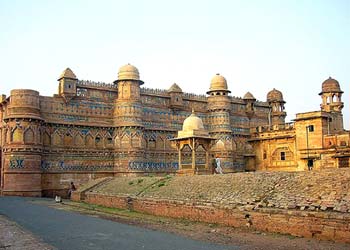Gwalior Travel Guide:

Introduction
Gwalior State was an Indian kingdom ruled by the Maratha dynasty. The state took its name from the old town of Gwalior, which, although never the actual capital, was an important place because of its strategic location and the strength of its fort. The state was founded in the early 18th century by Ranoji Sindhia as part of the Maratha Confederacy. Under Mahadji Sindhia (1761–1794) Gwalior State became a leading power in northern India, and dominated the affairs of the confederacy. The Anglo-Maratha Wars brought Gwalior State under British suzerainty, and it became a princely state of British India. Gwalior was the largest princely state in the Central India Agency, under the political supervision of a Resident at Gwalior. In 1936, the Gwalior residency was separated from the Central India Agency, and made answerable directly to the Governor-General of India. After Indian Independence in 1947, the Sindhia rulers acceded to the Government of India, and Gwalior state was absorbed into the new Indian state of Madhya Bharat.
History
The house of Sindhia traces its descent from a family of which one branch held the hereditary post of patil in Kannerkhera, a village 16 miles (26 km) east of Satara. The head of the family received a patent of rank from the emperor Aurangzeb, while a daughter of the house was married to the Maratha chief Shahu, son and successor of Sambhaji. The founder of the Gwalior house was Ranoji Sindhia, who belonged to an impoverished branch, and according to a story current in Sir John Malcolm's time had become a personal attendant on the Peshwa Balaji Baji Rao, and used to carry his slippers. He rose rapidly in favor, brought to the front by his soldierly qualities. In 1726, together with Malhar Rao Holkar, the founder of the house of Indore, and the Ponwar, he was authorized by the Peshwa to collect chauth (25% of the revenues) and sardeshmukhi (10% over and above the chauth) in the Malwa districts, retaining for his own remuneration half the mokassa (or his remaining 65 percent). Ranoji fixed his headquarters in the ancient city of Ujjain, which ultimately became the capital of the Sindhia dominion, and in 1745 he died near Shujalpur, where his centotaph stands. He left three legitimate sons, Jayappa, Dattaji, and Jotiba, and two illegitimate, Tukaji and Mahadji. Jayapa succeeded to the territories of Ranoji, but was killed at Nagaur in 1759. He was followed by his son Jankoji, who was taken prisoner at the Third Battle of Panipat in 1761 and put to death, and Mahadji succeeded.
Overview
The state had a total area of 64,856 km² (25,041 square miles), and was composed of several detached portions, but was roughly divided into two, the Gwalior or Northern section, and the Malwa section. The northern section consists of a compact block of territory with an area of 44,082 km² (17,020 square miles), lying between 22º10' and 26º52' N. and 74º38' and 79º8' E. It was bounded on the north, northeast, and northwest by the Chambal River, which separates it from the native states of Dholpur, Karauli, and Jaipur in the Rajputana Agency; on the east by the British districts of Jalaun and Jhansi in the United Provinces, and by Saugor District in the Central Provinces; on the south by the states of Bhopal, Khilchipur, and Rajgarh, and by the Sironj pargana of Tonk State; and on the west by the states of Jhalawar, Tonk, and Kotah in the Rajputana Agency.
The Malwa section, which included the city of Ujjain, had an area of 20,774 km² (8021 square miles). It was made up of several detached districts, between which portions of other states were interposed, and which were themselves intermingled in bewildering intricacy.
Development in the Gwalior State
Srimant Maharaja sahab Jayajirao Shinde was the Founder of Development in Gwalior after 1857 and worked for the peoples of gwalior to establish their own business. He was a very good artist of Gwalior Gharana Classical Music and opened a school for learning music. The Gwalior got its music in his regein. It was his sole efforts that made Gwalior the most advanced city of India. GCB - Knight Grand Cross Order of the Bath (medal 1.1.1877), GCSI - (25.6.1861), CIE (1.1.1878). In 1872 the state lent 75 lakhs for the construction of the Agra-Gwalior portion of the Great Indian Peninsular Railway, and a similar amount in 1873 for the Indore-Nimach section of the Rajputana-Malwa railway. A personal salute of 21 guns was conferred in 1877, and Jayajirao became a Counsellor of the Empress and later on a GCB and CIE. In 1882 land was ceded by the state for the Midland section of the Great Indian Peninsular Railway.
In 1885 Gwalior fort and Morar cantonment, with some other villages, which had been held by British troops since 1858, were exchanged for Jhansi city.
1940 Population and Area
In 1940 Gwalior State had 4,006,159 inhabitants and an area of 26,008 square miles.